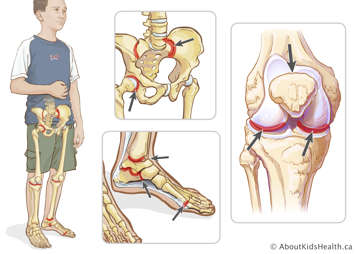What is juvenile idiopathic arthritis (JIA)?
Juvenile idiopathic arthritis (JIA) is arthritis that affects children who are less than 16 years old. It is also called childhood arthritis.
Arthritis means "joint swelling" or "joint inflammation." Arthritis leads to pain, swelling, stiffness and loss of motion in the joints. "Idiopathic" means that we do not know the cause.
What is enthesitis-related arthritis (ERA)?
There are many different types of arthritis. Enthesitis-related arthritis (ERA) is one type. Patients with ERA not only have joint swelling or inflammation (arthritis), but also have enthesitis. Enthesitis is swelling or inflammation of the entheses, the connective tissue where tendons or ligaments attach to bone.
Between 10% and 15% of all children with JIA have ERA. It is usually seen in late childhood or adolescence (eight to 15 years of age). It affects boys more often than girls.
The severity of ERA can vary. For some children, it can be mild and last only a short time. For others, it can be more severe and last a long time. Some children may develop inflammation in their back when they are adults.
ERA can also be called spondyloarthritis or ankylosing spondylitis.
These diseases are managed by rheumatologists, doctors who specialize in diseases of the joints and inflammation.
Enthesitis-related arthritis is an autoimmune disease
Inflammation (irritation and swelling) is a normal process in the body. It is how our immune system protects our bodies from bacteria and viruses that cause infection.
In ERA, like other types of childhood arthritis, there is no infection. Instead, the immune system is confused and attacks the cells and tissues in the body’s connective tissues including the joints, tendons and entheses. This leads to redness, swelling, pain, warmth, stiffness or loss of movement in the connective tissue. For this reason, ERA is called an autoimmune disease. So far, we do not know what causes it. There is nothing that you did or did not do to cause your child’s ERA.
Signs and symptoms of enthesitis-related arthritis
The arthritis in ERA is mainly in the lower limbs (hip, knee, ankle and foot). Arthritis in the back (spondylitis) and the base of the spine at the sacroiliac joint (sacroiliitis) is not as common at first, but can occur later. Children with spondylitis or sacroiliitis often complain of lower back or buttock pain that is worse with rest and better with activity. Arthritis can also occur in the upper limbs, especially the shoulders.

The most common areas affected by enthesitis are the knees, heels and bottom of the feet. As a result, children with enthesitis report heel, foot or knee pain, with or without swelling. To help with enthesitis pain in the foot and heel, your child’s health-care team may recommend supportive footwear and padded heel inserts for your child's shoes.
Symptoms of ERA can come and go. Sometimes your child may have a flare of their disease when there is more pain and swelling of joints and/or entheses.

Possible other symptoms of ERA
For some patients with ERA, inflammation can occur in other areas of the body as well. Not all children with ERA will have these symptoms, but doctors will always be checking for:
- Eye inflammation occurs in up to 30% of children who have ERA. It usually occurs in one eye and can reoccur. Inflammation occurs in the iris, where it is called acute anterior uveitis. The eye is usually red, painful and sensitive to light. Eye inflammation is an emergency. Your child will need to see an eye doctor (ophthalmologist) right away. Your child will need to have routine eye exams with a "slit lamp" to look for early signs of eye inflammation. Please speak to your child’s doctor about how often your child will need to have an eye exam.
- Skin inflammation can also occur in children with ERA. Inflammation in the skin is called psoriasis. This is a persistent skin rash that looks like red patches covered with white scales. It can be found on the scalp, underarms, elbows and around the belly button.
- Bowel inflammation can also occur in children with ERA. Inflammation in the bowel (intestines) is called inflammatory bowel disease (IBD). There are two types of IBD: Crohn's disease, and ulcerative colitis.
Diagnosis of enthesitis-related arthritis
There are several steps to diagnosing ERA. The doctor will ask you about your child's symptoms and medical history and will also do a physical exam to look for joint inflammation. They may suspect ERA when a child has joint pain and swelling, especially in the lower limbs; pain in the lower back or buttocks; or signs of enthesitis for more than six weeks. The doctor will usually order blood tests, X-rays and sometimes additional tests, like magnetic resonance imaging (MRI), to help diagnose the disease.
One blood test that can be helpful when trying to diagnosis ERA is the HLA-B27 genetic marker. It can tell us who is at higher risk of developing ERA. Most children with ERA are "positive" for the HLA-B27 marker, but it is important to note that:
- Not every person who carries this marker will have ERA.
- A child can have ERA and still be "negative" for HLA-B27.
Treatment of enthesitis-related arthritis
ERA is treated with various types of medicine:
- Some medicine can improve symptoms of inflammation, helping to reduce pain and stiffness and improve movement in the joints.
- Some people with ERA need stronger medicine that suppresses the immune system and helps to control inflammation and prevent joint damage.
Your child will be followed by a rheumatology team including doctors, nurses, physical therapists, social workers, dieticians and child life specialists. This team has a lot of experience treating children with ERA.
For more information, please see Juvenile enthesitis-related arthritis: Treatment, Living with ERA, Exercises for enthesitis and arthritis and Enthesitis-related arthritis: A guide for teenagers.
